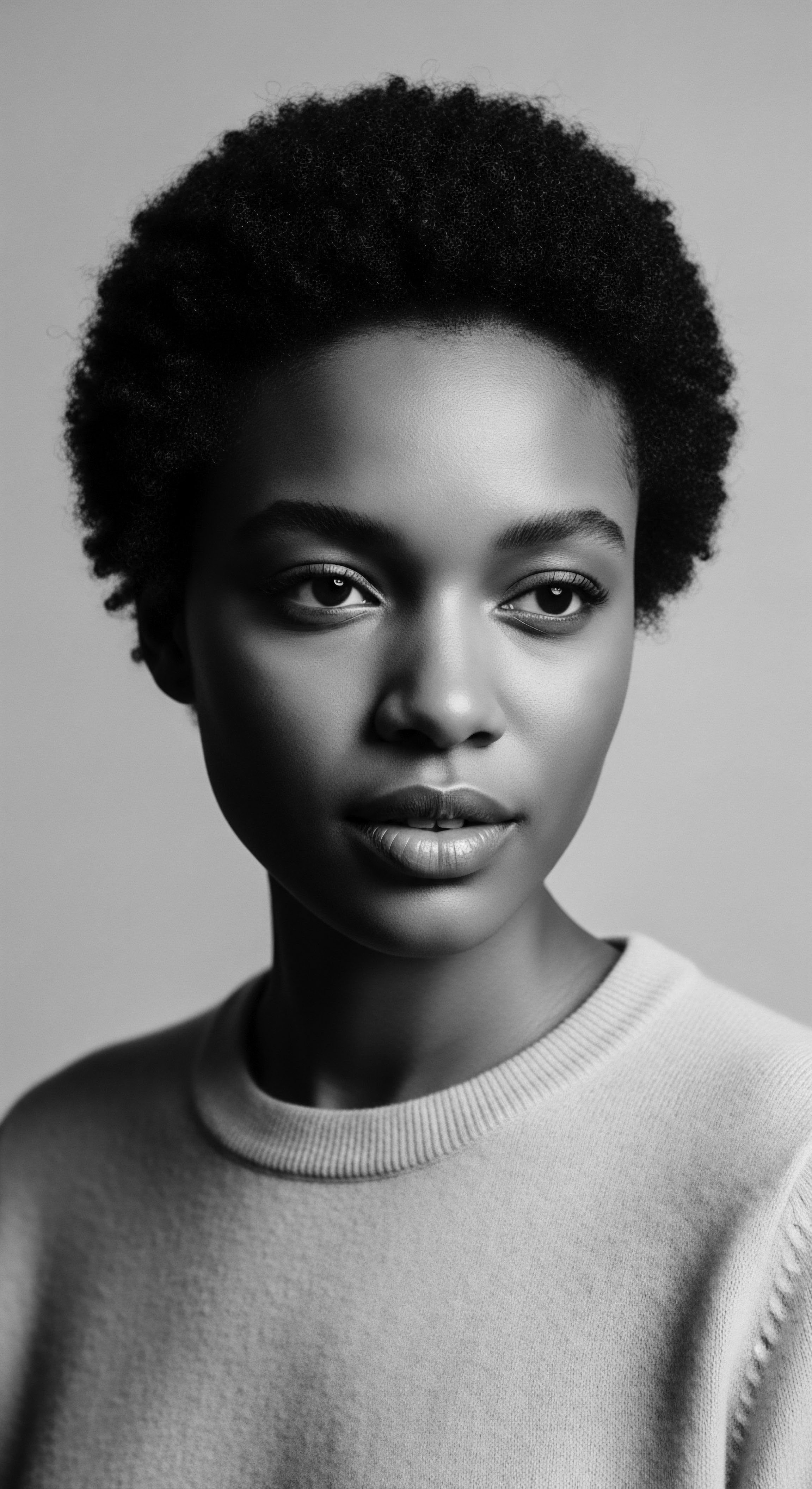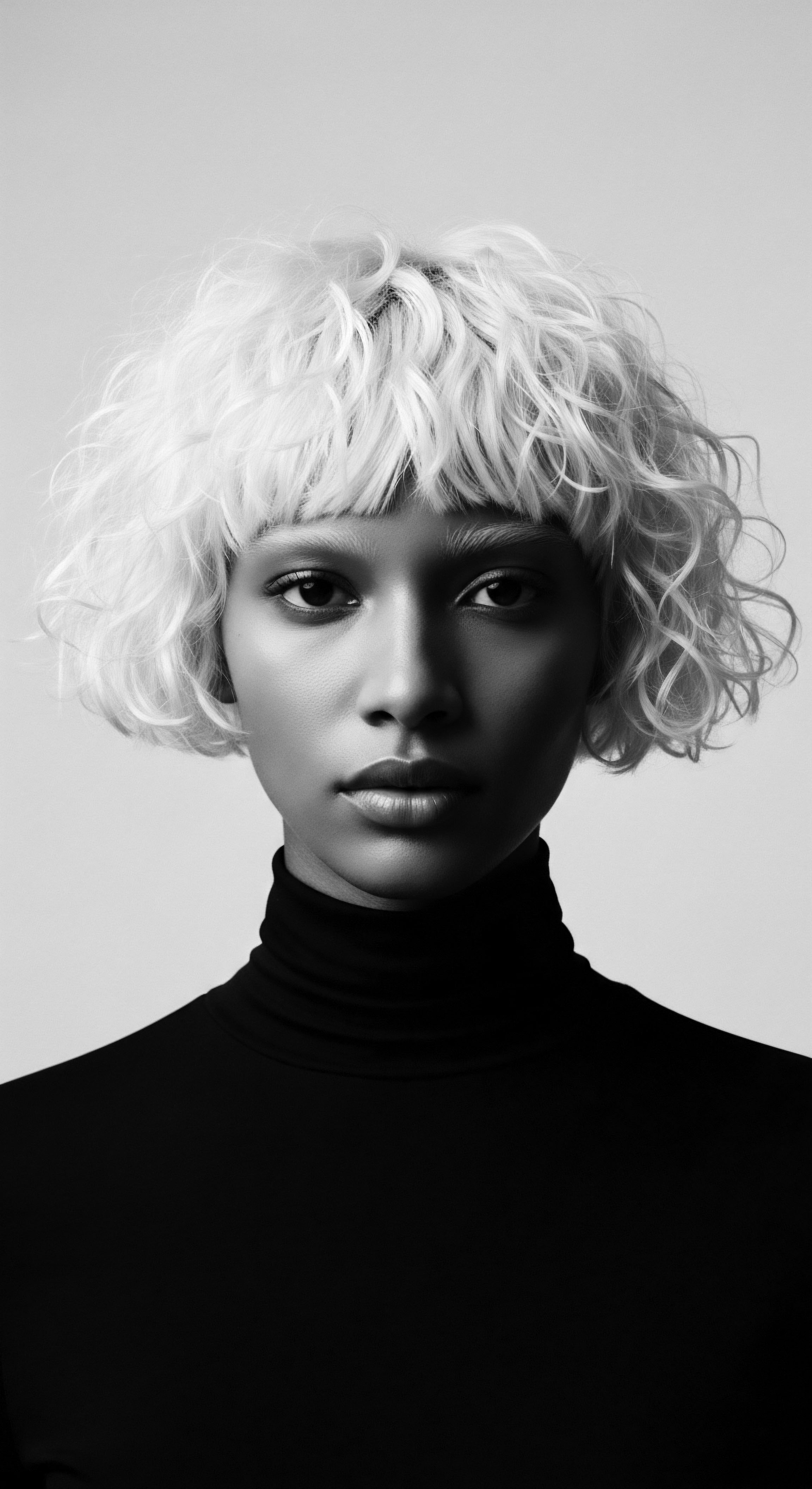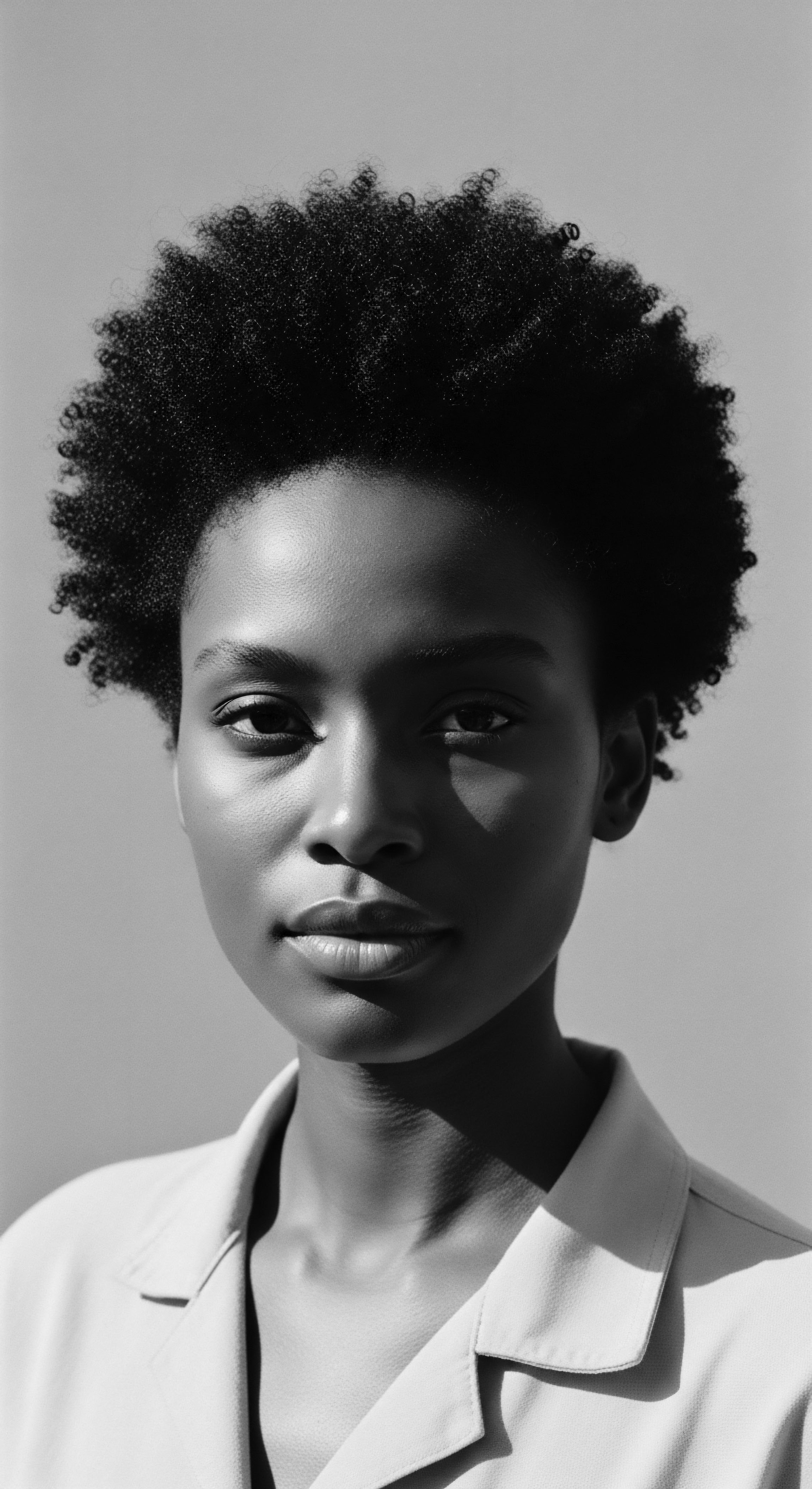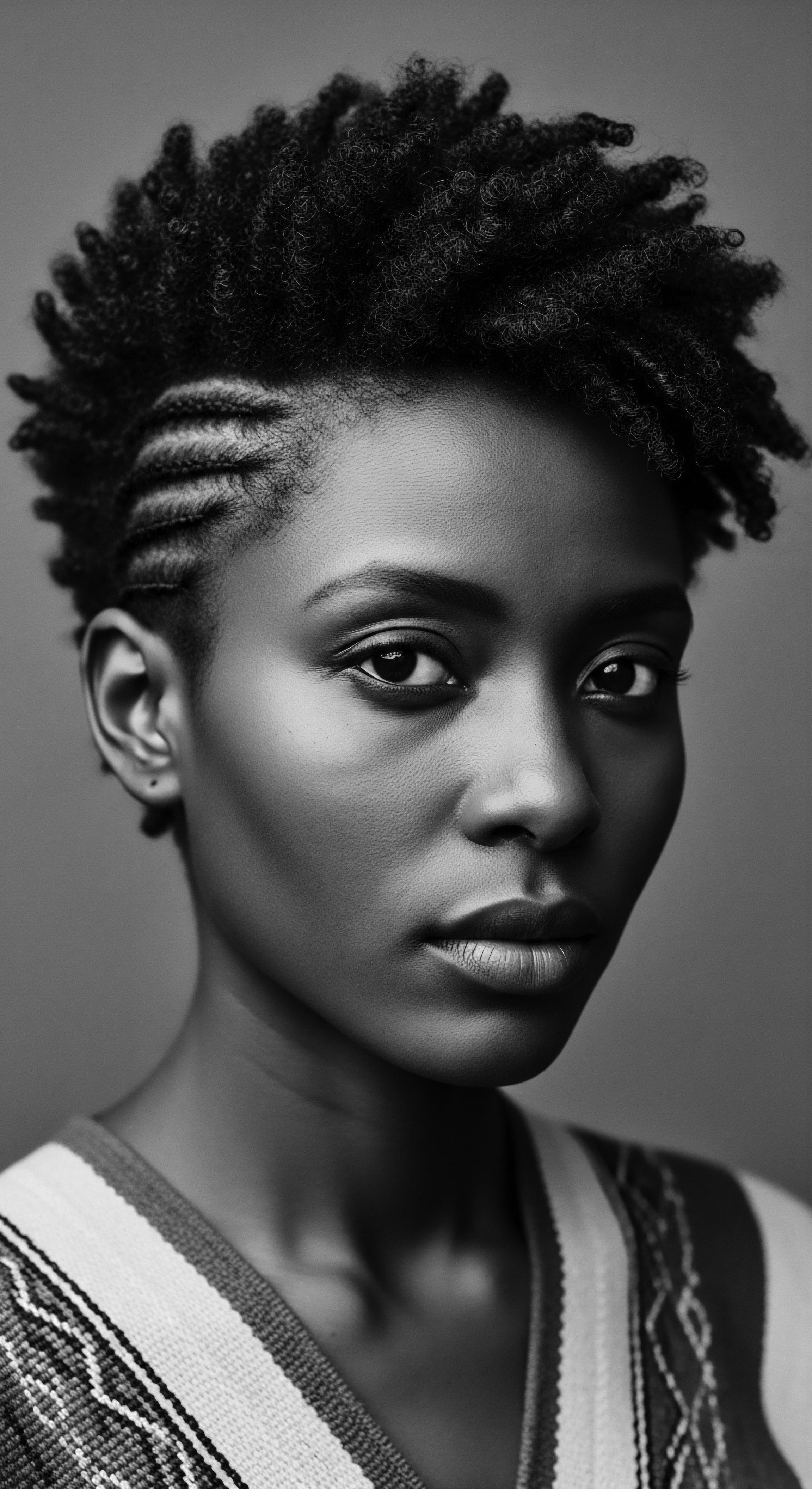
Roots
Consider a single strand, born from the scalp, a living testament to generations. It coils, it turns, it dances with an inner rhythm that echoes ancestry. Yet, for many, this dance is often accompanied by a persistent thirst, a dryness that whispers through every curl and kink. How does science explain this characteristic moisture deficit in Afro-textured hair, and how does this understanding connect to the deep well of our collective heritage?
We begin by looking at the very structure of the strand, understanding that its physical architecture, a legacy coded within us, plays a starring role in its hydration needs. This is not simply about what we see; it is about the stories etched into each fiber, stories that science now helps us interpret, offering pathways to care that honor both biology and ancestral wisdom.

What Makes the Structure of Afro-Textured Hair Unique?
At its elemental core, all human hair shares the common building block ❉ Keratin Protein. This resilient protein forms the bulk of the hair shaft. Yet, the way these keratin units arrange themselves, the path they take as they emerge from the scalp, varies distinctly across hair types. Afro-textured hair distinguishes itself with an elliptical cross-sectional shape, contrasting with the more circular or slightly oval form found in Caucasian hair.
Furthermore, the hair follicle itself, buried within the scalp, displays a retrocurvature, an asymmetrical S-shape. This unique follicular architecture dictates the tight coiling and zig-zag patterns seen in Afro-textured hair.
These coils, while visually striking, create numerous points of curvature along the hair shaft. Each bend, each twist, represents a potential area of weakness. The cuticle, the hair’s outermost protective layer, consists of overlapping scales, similar to shingles on a roof.
In Afro-textured hair, these scales are often smaller and may be less tightly packed around the sharp curves of the strand, making the cuticle naturally more raised. This natural lifting means the cuticle is not as smooth a barrier as it might be on straighter hair, allowing moisture to escape more readily.
The distinctive coiled structure of Afro-textured hair, originating from its unique follicular shape, presents inherent challenges to moisture retention.

Does Lipid Content Affect Hair Dryness?
The hair’s ability to retain water is also linked to its lipid content. Lipids, comprising fatty acids, ceramides, glycolipids, and cholesterols, form a laminated structure that acts as a barrier against external factors and maintains moisture. Surprisingly, despite its perceived dryness, Afro-textured hair reportedly has the highest overall lipid content, estimated to be 2.5 to 3.2 times higher than European and Asian hair, respectively. This includes a higher internal lipid content and a greater quantity of free fatty acids, sterols, and polar lipids.
However, research suggests that the distribution of these lipids may hold a clue. While Afro-textured hair has more lipids, these lipids, particularly sebaceous lipids from the scalp, face a challenge traveling down the tightly coiled hair shaft to the ends. This uneven distribution means that the ends, being the oldest and most exposed parts of the hair, often receive less natural lubrication, contributing to their dry appearance. Moreover, some studies indicate that Afro-textured hair lipids exhibit lower hydration levels and less ceramide content, a fatty acid vital for protecting and strengthening hair’s internal components, which may also contribute to weakness and reduced elasticity.
The growth cycle of Afro-textured hair also differs. It has been found to have a slower growth rate compared to Caucasian hair, with more hair fibers in the telogen (resting) phase. This slower growth rate, combined with the structural fragility at the points of curvature, can contribute to dryness and breakage over time.
| Characteristic Follicle Shape |
| Afro-Textured Hair Elliptical, retrocurved S-shape |
| Other Hair Types (General) More circular or slightly oval, straighter |
| Characteristic Hair Shaft Shape |
| Afro-Textured Hair Elliptical cross-section, tightly coiled |
| Other Hair Types (General) Circular or slightly oval, straighter/wavy |
| Characteristic Cuticle Layers |
| Afro-Textured Hair Fewer layers (8-12), often naturally raised |
| Other Hair Types (General) More layers (Asian hair >12), smoother (Caucasian 4-7) |
| Characteristic Lipid Content |
| Afro-Textured Hair Higher overall lipid content, but uneven distribution |
| Other Hair Types (General) Lower overall lipid content |
| Characteristic Moisture Retention |
| Afro-Textured Hair Prone to dryness due to structural challenges, loses moisture quickly |
| Other Hair Types (General) Generally retains moisture more easily |
| Characteristic Growth Rate |
| Afro-Textured Hair Slower growth rate, more fibers in telogen phase |
| Other Hair Types (General) Faster growth rate |
| Characteristic The unique biological architecture of Afro-textured hair, a direct legacy of ancestral adaptations, creates specific considerations for hydration that modern science helps to clarify. |

Ritual
From the very anatomy of the strand, we turn to the living practices that have, for generations, acknowledged and addressed the particular needs of Afro-textured hair. These are the rituals, steeped in tradition and ancestral wisdom, that speak directly to the science of maintaining moisture. Our foremothers understood, perhaps without microscopes or chemical analysis, the whispers of their hair and adapted their care accordingly. These practices, honed over centuries, represent a profound, intuitive science passed down through communal knowing.

How Have Ancestral Hair Practices Addressed Moisture?
Long before modern formulations, communities across Africa and the diaspora developed sophisticated methods to tend to their coils and kinks. These practices, though varied, consistently reveal a deep understanding of the hair’s need for hydration and protection. Natural butters, herbs, and powders were central to these traditions, specifically aimed at retaining moisture.
Consider the women of the Bassara/Baggara Arab tribe in Chad, whose practice of using Chébé Powder is a testament to ancestral ingenuity. Chébé, sourced from the Northern Chad mountains, is traditionally mixed with water to create a paste or combined with moisturizing substances like Shea Butter. This mixture is applied to hydrated hair, which is then braided to seal in the moisture.
While modern science explains this as the powder filling hair shaft spaces and sealing the cuticle, our ancestors knew it simply as a way to promote length retention and keep hair healthy. This practice, passed down through generations, highlights a core principle ❉ the application of moisture and then a protective layer to prevent its escape.
A significant historical example of addressing dryness through cultural practices emerges during the period of enslavement. African populations, forcibly transported to the Americas, faced the brutal attempt to erase their cultural identity, including the cutting of their hair. Despite this dehumanization, hair care persisted as a symbol of resilience and cultural expression. Enslaved people utilized whatever natural materials were available, such as Shea Butter, Coconut Oil, and even animal fats, to moisturize and protect their hair from harsh conditions.
The use of pieces of clothing as headscarves was not only for ceremony but also served a practical purpose ❉ to protect hair and retain its moisture, a practice that continues today. This speaks to an intuitive, generational understanding of sealing and protection against environmental elements.
Ancestral hair care rituals, born from intimate knowledge of the hair, intuitively employed moisturizing agents and protective measures long before scientific validation.
The science behind these practices is becoming clearer today. The use of oils and butters acts as emollients and sealants, smoothing the hair cuticle and creating a barrier that minimizes moisture loss. Ingredients like shea butter, rich in fatty acids and vitamins, condition and seal effectively.
Coconut oil, with its unique ability to penetrate the hair shaft, has been shown to reduce protein loss and seal in moisture. These natural compounds work to support the hair’s external lipid layer, which is responsible for retaining moisture and protecting strands.
- Shea Butter ❉ A thick, yellow paste from the nuts of the Karite tree, traditionally used as a moisturizer and sealant, rich in vitamins A, E, and F, offering sun protection.
- Coconut Oil ❉ Known for penetrating the hair shaft, reducing protein loss when applied prior to washing, and sealing in hydration.
- Chébé Powder ❉ A finely ground powder from Chad, mixed with water or butter, used to coat hair strands and seal moisture into the cuticle for length retention.
- Karkar Oil ❉ A blend, often including sesame oil, known for nourishing the scalp and strengthening hair follicles to address dryness and flakiness.

How does Protective Styling Play a Role?
Protective styling, deeply rooted in African traditions, serves as a practical application of understanding Afro-textured hair’s needs. Styles such as braids, cornrows, and twists, dating back thousands of years in African culture, were not just aesthetic expressions; they were fundamental to hair health.
By tucking away the hair ends, which are the most vulnerable to breakage and dryness, these styles minimize exposure to environmental stressors and daily manipulation. This reduction in physical trauma helps to preserve the cuticle layer, which, when damaged, allows moisture to escape. The scientific understanding of hair fragility indicates that Afro-textured hair is more susceptible to breakage due to its coiled shape, and minimizing mechanical stress is vital.
Protective styles allow hair to retain its natural moisture more effectively, as the coils are less exposed to dry air, friction from clothing, and manipulation from hands or brushes. This ancestral wisdom of styling for preservation aligns perfectly with modern scientific recommendations for reducing hair breakage and supporting length retention.

Relay
The wisdom of our ancestors, passed down through the ages, now finds resonance in the contemporary understanding offered by scientific inquiry. The scientific explanation of Afro-textured hair’s dryness is not a separate narrative but a relay, a continuation of knowledge that deepens our appreciation for inherited practices. We move from the observations of generations to the microscopic world, where the interplay of physics, chemistry, and biology paints a more complete picture of why these coils thirst.

What does Hair Porosity Tell Us about Moisture Needs?
Hair porosity describes the hair’s ability to absorb and retain moisture, determined by the state of its outermost layer, the cuticle. The cuticle layers, which resemble overlapping scales, open and close to allow water and conditioning agents to enter or exit the hair shaft.
Afro-textured hair often exhibits what is termed ‘high porosity,’ meaning its cuticle layers are naturally more raised or open. This allows moisture to enter easily but also allows it to escape with similar ease. The consequence is hair that hydrates quickly but dries out rapidly, leading to the characteristic dryness experienced by many. This inherent structure, stemming from the elliptical shape of the hair follicle and the numerous bends along the coiled shaft, contributes to the cuticle’s tendency to remain slightly lifted.
The open cuticle of Afro-textured hair, a consequence of its coiled form, facilitates quick absorption but also rapid loss of hydration.
This scientific insight explains why ancestral practices focused on sealing moisture were so effective. When women in ancient West African communities applied nutrient-rich butters and oils after hydrating their hair, they were, in effect, compensating for this high porosity by laying down a protective layer over the open cuticles. The choice of specific ingredients like Castor Oil and Shea Butter, frequently used in historical contexts, is scientifically sound. Castor oil, a viscous lipid, creates a substantial barrier, while shea butter, a blend of fatty acids, smoothes the cuticle and reduces water evaporation.
Beyond porosity, the very shape of the strand affects how natural oils from the scalp travel along the hair shaft. In straight hair, sebum can glide down the length with ease. For Afro-textured hair, the tight curls and zig-zag patterns create a tortuous path, making it difficult for sebum to evenly distribute from root to tip.
This uneven distribution leaves the mid-shaft and ends particularly susceptible to dryness, as they receive less of the scalp’s natural conditioning agents. This is a fundamental biophysical reality, necessitating external applications of moisture and emollients.

How do Proteins and Bonds Impact Hair’s Moisture Balance?
Hair is primarily composed of keratin, a protein that gives it strength, shape, and elasticity. This protein structure is held together by various bonds, including disulphide and hydrogen bonds. While disulphide bonds determine the hair’s curl pattern and strength, hydrogen bonds are easily broken by water and temporarily reset by heat.
When hair lacks moisture, its protein structure can be compromised. Dryness makes the hair brittle, weakening these protein bonds and increasing susceptibility to breakage. This creates a cyclical challenge ❉ dry hair is more prone to damage, and damaged hair (with compromised cuticles and weakened protein structures) struggles even more to retain moisture. The layers of the cuticle, vital for protection, can become worn or lifted with rough handling, heat styling, or chemical treatments, exposing the inner cortex and accelerating protein loss.
The cultural context of styling also plays a role here. While styles like braids and cornrows offer protection, excessive tightness or improper removal can lead to strain on the hair roots and strands, causing damage. Historically, the pressure to conform to Eurocentric beauty standards often led to the use of harsh chemical relaxers and excessive heat, which significantly compromise the hair’s protein structure and cuticle integrity, exacerbating dryness and fragility. This unfortunate reality underlines the importance of caring for Afro-textured hair in ways that honor its inherent structure and preserve its integrity.
Modern science and ancestral wisdom converge on the truth that proper care must support both moisture and protein balance.
- Water-Based Products ❉ Act as the primary hydration source, directly addressing the hair’s thirst. Ancient methods using herbal rinses or simply water before applying oils exemplify this.
- Oils and Butters ❉ Serve as sealants, preventing the rapid evaporation of water from the hair shaft. This validates the widespread traditional use of ingredients like shea butter and coconut oil.
- Deep Conditioning ❉ Aids in moisture retention and can be performed weekly or biweekly. This practice reinforces the hair’s protein structure and smooths the cuticle.
- Protein Treatments ❉ Help rebuild damaged strands and strengthen hair, particularly when chemical treatments or excessive heat have compromised its structure.

Reflection
The journey into the science of Afro-textured hair’s dryness is a profound meditation on heritage. It reveals that the scientific explanations we now grasp, with their intricate details of follicular shape, cuticle structure, and lipid distribution, do not diminish the wisdom of past generations. Instead, they illuminate and validate the ancestral practices that were, in essence, early forms of applied science. Our foremothers, through observation and communal knowledge, understood the thirst of their strands and developed ingenious solutions from the earth around them.
This understanding of hair’s inherent nature, coupled with the legacy of care, stands as a living archive, a ‘Soul of a Strand’ that continues to speak to us. It reminds us that our hair is more than just biology; it is a profound connection to identity, resilience, and the enduring beauty of Black and mixed-race experiences. As we continue to seek knowledge and refine our care practices, we do so not in isolation, but standing on the shoulders of those who came before, honoring their insights and weaving them into our present and future. Each drop of moisture, each gentle comb, becomes a continuation of a timeless ritual, a silent conversation with generations of wisdom.

References
- Gittens, G. (2011). Hair Care & Styling for African American Women ❉ A Guide. Black Classic Press.
- MDPI. (2024). The Genomic Variation in Textured Hair ❉ Implications in Developing a Holistic Hair Care Routine. Retrieved from MDPI.com.
- Cosmetics & Toiletries. (2020). Defying Damage ❉ Understanding Breakage in Afro-textured Hair.
- American Academy of Dermatology. (2025). Historical Perspectives on Hair Care and Common Styling Practices in Black Women. Retrieved from AAD.org.
- Salford Students’ Union. (2024). The Remarkable History Behind Black Hairstyles.
- EBSCO Research Starters. (2023). Afro-textured hair.
- estherotomi. (2015). BLACK HAIR SCIENCE ❉ THE STRUCTURE OF AFRO TEXTURED HAIR.
- RevAir. (2023). The Science Behind Drying Curly Hair ❉ Understanding Your Curls and Heat Styling.
- Black Afro Hair. (2013). THE SCIENCE OF HAIR – PART ONE (The Basics).
- Obscure Histories. (2024). Ancient Gems ❉ A Historical Survey of African Beauty Techniques.
- The Science of Afro Hair. (2025). Why It Needs Special Care.
- The Solid Bar Company. (2021). Essential Guide To Curly & Afro-Textured Hair.
- Trichologist, K. (2023). Waves, Curls, and Coils ❉ Understanding Curly Hair Types from a Trichologist.
- Root2tip. (2024). Ayurveda For Afro Hair.
- MDEdge. (2025). Historical Perspectives on Hair Care and Common Styling Practices in Black Women.
- Carra. (2021). The Science of Textured Hair.
- Doria Adoukè. (2022). All you need to know about afro hair.
- Jaycee Naturals. (2024). Lovely Lipids ❉ How These Ingredients Nourish Textured Hair.
- KokoroAfroBeauty. (2025). Etsy Shop Announcement.
- NaturAll Club. (2021). Protein And Moisture For Hair ❉ Which One Do You Need?
- MDPI. (2024). Cosmetopoeia of African Plants in Hair Treatment and Care ❉ Topical Nutrition and the Antidiabetic Connection?
- Black Panther Strong. (2025). Hair Care for Afros ❉ Essential Tips for Healthy Growth.
- Tanex Marketing and Distribution. (2025). Conquering Dryness in Your Afro Hair.
- Chebeauty. (2024). Nourish Your Roots ❉ Essential Care Guide for Dry Afro Hair Scalp.
- Popular Science. (2023). Researchers develop a new super-scientific way to understand curly hair.
- PubMed Central. (2017). Hair Breakage in Patients of African Descent ❉ Role of Dermoscopy.
- Reddit. (2021). No raw oils and butters vs. Traditional African hair care? ❉ r/Naturalhair.
- ResearchGate. (2024). Cosmetopoeia of African Plants in Hair Treatment and Care ❉ Topical Nutrition and the Antidiabetic Connection?
- Hairducation. (2019). Damaged Hair ❉ What Is It, How does it Happen and Why Afro Textured Hair Is Prone to It.
- Ethnobotany Research and Applications. (2025). Plants used for hair and skin health care by local communities of Afar, Northeastern Ethiopia.
- Odele Beauty. (2021). A Science-Based Guide To Frizzy Hair.
- LeafScore. (2025). Natural Hair Products for Afro-Textured Hair.
- 22 Ayur. (2023). The Ancient Natural Ways of Hair Care Across Continents.
- Kerastase. (2023). The Scientific Truth Behind Curly Hair.
- E3S Web of Conferences. (2025). Ethnopharmacological survey of home remedies used for treatment of hair and scalp and their methods of preparation in the West Bank-Palestine.
- CRLab. (n.d.). Structure and chemical composition of hair.
- BioRestore Health. (2025). How Bad Hair Habits Affect the Protein Your Hair Needs.
- Philip Kingsley. (2022). Hair Biology & Bonds.
- Substack. (2025). Ancestral Hair Rituals to Nourish Your Hair and Soul.
- The Journal of Clinical and Aesthetic Dermatology. (2009). African American Women, Hair Care, and Health Barriers.
- VisualDx. (2024). Enhancing Dermatological Care ❉ Understanding the Science and Significance of Afro-Textured Hair.
- BLAM UK CIC. (2022). The history of Black Hair.
